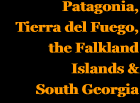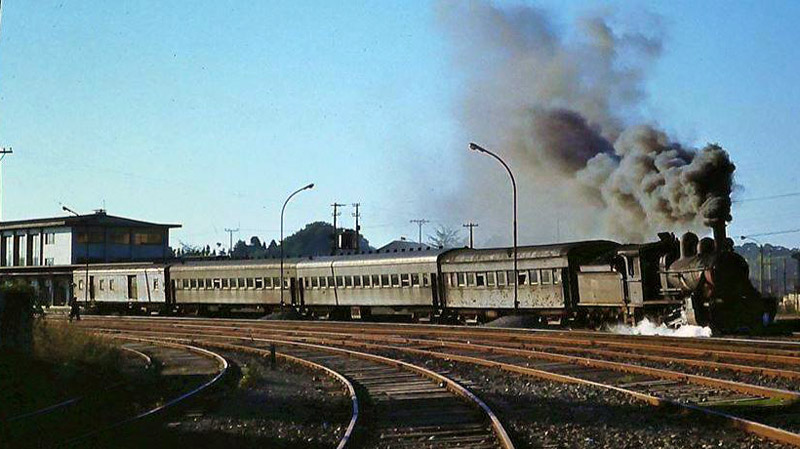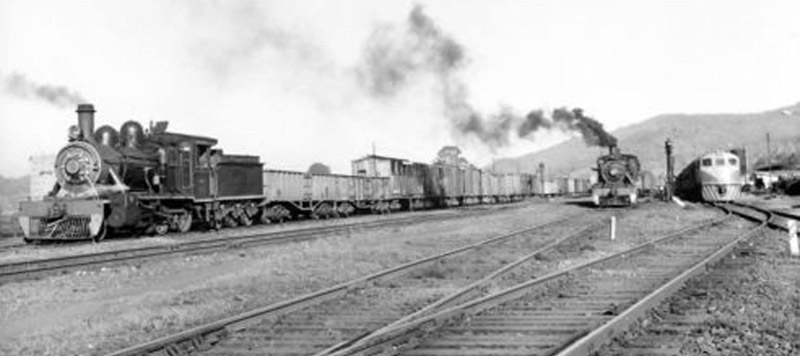 |
|||||||||||||
 |
|||||||||||||
 |
|||||||||||||
 |
|||||||||||||
Main pages
Appendices
4 Pichi-Ropulli Osorno report •
9 Branchline station photos 2 •
11 Barros Jarpa Noel agreement ª
Chapter 5
The south end of the Chilean broad gauge


Operations
A passenger train hauled by a tipo 57 2-6-0 departs southbound from the replacement Osorno station. Photographer unknown.

A visitor to a southern Chilean wayside stations might initially have thought that the mode of operation was very different from that at an equivalent location in Argentina. Instead of British style home signals on the approaches to the station he would have seen a single central signal post bearing two lower quadrant arms – one each side and facing each way. These señales de salida were effectively both home and starting signals; if ‘clear’ a train had permission to run on through, whilst if ‘at danger’ an approaching driver had to stop and await permission to enter the station. At a minor passing place this would have been given by a hand or lamp signal from the cambiador or shunter, whilst at more important locations additional fixed signals would have been provided.
However, looking a little more closely, the system of operations and interlocking would have been found to be very familiar. Paper vía libre orders were commonly used, with authorisation by telegraph or telephone. On busier routes miniature train staff instruments were gradually introduced much as occurred further east, though the staffs were known as bastones rather than palos. A further development saw a more comprehensive system of home and starting signals interlocked to the staff aparato, so that the signal could not be cleared unless a staff had been taken out of the machine. The convention was in fact known as el sistema Saxby, recalling John Saxby, later of Saxby & Farmer, Kilburn, London, who invented modern interlocking and who no doubt supplied some of the early equipment.
Permission to extract a bastón from the machine having been given by control, it was normally fastened into a pouch attached to a hoop, and the whole device placed on a post to facilitate its passing to the engine crew without their stopping. If necessary a written order might have been added to the pouch, for example to warn of the need to stop at a station ahead. Having caught the hoop and checked that the token is the correct one for the route ahead, the driver may salir a la recta, or depart into the single line section. Automatic token catchers were fitted to locos operating on the mainline down to Puerto Montt in the 1940s, but seem to have been little used.
On principal lines further north a fourth level of sophistication saw full señalizado eléctrico, eventually to be integrated into Centralized Traffic Control, known as CTC even in Chile. However, such complexity never made it onto our southern lines.
Ordinarios and sobornaleros
We have met trenes mixtos many time already – mixed trains conveying both passengers and goods traffic – but Chile had a number of other special names for types of train. Passenger trains could be expresos, or ordinarios, whilst fast freights could be nocturnos or, less formally, be known in the south as the ganaderos (literally the ‘stockmen’) as they carried livestock to the cities further north.
Less urgent goods were dealt with by what in other countries might be known as ‘pick-up’ or ‘wayside’ freight trains. From the 1939 working timetable it appears that most of this work was done by mixtos, or mistos to use the old Chilean spelling, but by 1952 roles had been separated. Mixtos would still carry whole wagonloads, but other traffic was dealt with by trenes sobornaleros. The term defies easy translation. Literally it means ‘one who is bribed’, but in this context it implies the picking up and setting down by request, not only of whole wagons, but also of part-loads and individual crates or drums.
To this end, the train guard in his van, either of them also sometimes known as el sobornalero, would originally have had the help of several palanqueros. In the old days these would have also been brakesmen, but the term survived the introduction of through air-brakes to such an extent as to imply that they were retained as loading assistants.
Timetables
A page from the winter working timetable for 1939 is shown below. This tells us little about the branches, for most were still under construction at that time, but is more instructive for the mainline. A dedicated passenger train ran just twice a week from Osorno to Valdivia, taking four hours, whilst another ran three times a week from Puerto Montt up to Temuco. There was a daily ordinario from Valdivia northward to Concepción and Talcahuano, but notably no through trains to Santiago.
Supplementing them, and carrying goods, were eight mixtos a week between Puerto Montt and Osorno, four a week onward to Valdivia, and surprisingly just five a week allowed for northward to Temuco. The main freights must have been unscheduled and dispatched as necessary. Quite apart from traffic from the ports, the as-yet-incomplete Los Muermos branch was running eight mixtos a week around that time, and something must have taken on all the wagons from the junction at Corte Alto.
By 1952 most of the branches were up and running. That to Lago Ranco can serve as an example: a 5am goods train from the terminus ran right through to Valdivia six days a week, arriving at 4pm, whilst there were also ten mixtos a week as far as the junction at La Unión, taking 2¼ hours for the 66 km. The Los Muermos line saw a very similar pattern, with the goods running as far as Osorno.
A 1974 view of the junction at Antilhue. The photographer was looking east, and the far right hand track on which a GE ‘shovelnose’ Co-Co is standing, leads to the big balloon loop which enables through traffic from the north to proceed directly towards Osorno and Puerto Montt.

Traffic patterns
Whilst we do not have figures for each and every year, sufficient are available to making it possible to spot some trends. The graph below therefore shows those annual figures that are available as columns – red for passengers and yellow for goods. Within each column the main darker section represents the southern mainline to Valdivia and Puerto Montt, whilst the paler top sections show the figures for each of the four branches, including the metre gauge Riñihue line after its takeover by the EFE in 1942. The short-lived sub-branch to Puyehue has been included in the Lago Ranco line figures, whilst the even more ephemeral Las Quemas stub does not appear at all in the available annual statistics.
The figures for the broad gauge Red Sur as a whole are displayed in the background as polygons at a scale of 1/10 of the columns in front. Thus if the top of a column is level with the top of the background polygon for any given year it means that traffic in the area south of Lanco was equal to 1/10 of the Red Sur figures that year.
Taking the (red) passenger figures first: in the 1930s traffic in the south seems to have been rising more rapidly than over the network as a whole. From then on the trend is unequivocally upward, with both sets of figures moving in parallel until the mid 1960s, and then – if the 1970s numbers are to be believed – there came a distinct fall both on a network-wide basis and more locally.
The local freight figures (in yellow) grow steadily in the late 1930s but thereafter are rather more erratic than the overall Red Sur statistics, perhaps because the southern zone was more dependent on just a few major types of goods. Interestingly the totals carried from southern area stations start to fall from around 1960 though the network figures are still recovering through the decade to 1970 from a trough in the late 1950s.
The highest annual total for freight seems to be in the early 1950s, after which no doubt road traffic increasingly made its mark. The maximum passenger figures, however, came as late as 1965, possibly because most roads were still unsurfaced in the 1950s and very likely also because political pressure means that nationalised transport systems tend to keep ticket fares low even when networks are increasingly making losses.
Comparing the national levels with those in the south, the general pattern seems to be that around 9% of the Red Sur’s passengers originated in our zone of interest, but that between 1940 and 1965 the goods traffic generated there made up between 10 and 15% of the network’s loads, though that dropped to 9% later in the ‘60s. The difference between the passenger and freight percentages should be no surprise. The south was relatively lightly populated but, having a rather wetter climate than than some areas further north, it could generate substantial amounts of timber and agricultural produce. There may also have been coal from the mines at Máfil and elsewhere, though no figures are available.
As for the branches, a glance at the paler top sections of the bars shows unsurprisingly that their traffic levels were relatively low. The most productive were the Riñihue and Lago Ranco lines, but as a whole the branches, even in their relative best years during the 1960s, generated no more than 22.5% of the goods traffic in the area and 18.4% of the passengers, despite at that point making up 41% of the total track mileage in the area.
11-3-2018